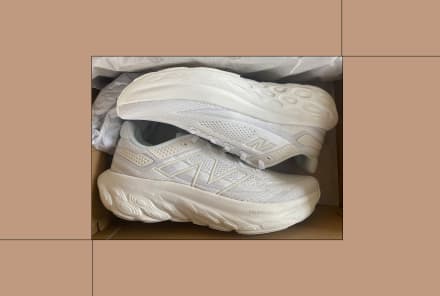Advertisement
Sauna vs. Steam Room: Which Heat Therapy Is More Effective?


Heat therapy is a super—well, hot—topic in the well-being space. If you love the idea of getting a sweat on but are unsure whether to seek out a sauna or a steam room (or even what the difference is), you've come to the right place.
We talked to medical experts to find out the differences between a sauna and a steam, the unique benefits each has to offer, and when and why you should choose one over the other.
What is a sauna vs. a steam room?
Both saunas and steam rooms bring your body into hormesis—a state of mild, controlled stress that can help repair cellular damage1 and support immunity2. By raising what energy specialist Ari Whitten called our "resilience threshold" on his episode of the mindbodygreen podcast, hormesis helps us better respond to all sorts of stressors—and be healthier and longer-lived because of it.
The difference between a sauna and a steam room comes down to the type of hormesis-inducing heat that they provide, explains Safdar Naueen, M.D., an internal medicine doctor at EHE Health. While a sauna is a dry heat, a steam room produces—as the name would suggest—a steamy, humid environment.
A sauna, with its dry heat at temperatures of 180 to 200 degrees Fahrenheit, is ideal for relieving sore muscles3, increasing blood flow4, and promoting faster recovery5 after a tough workout. Saunas have long been an essential health tool in Scandinavian countries, and their benefits are starting to go global.
Meanwhile, a steam room is slightly cooler, closer to 110 to 120 degrees Fahrenheit, with near 100% humidity, creating a heavy, moist feeling as soon as you walk in. Steam rooms, similar to saunas, also help with muscle soreness and recovery6.
Steam room benefits.
- Loosen phlegm and mucus
- Helps with joint pain
- Hydrates skin
- Soothes muscles
"Steam helps loosen phlegm and mucus, improving congestion and breathing," says Safdar. However, research shows that if you have a respiratory illness or infection7, steam alone will not clear it up for you.
There isn't a ton of research on the other benefits of stepping into a steam room (saunas have been much more extensively studied), but Safdar adds steam sessions have been scientifically shown to temporarily stave off muscle soreness6 and reduce joint pain and stiffness8. "The steam helps the body relax, and stiff joints get some relief," she says.
And, for those looking to top off their spa day, Safdar says, a steam room can also help temporarily hydrate the skin (though steaming too much can strip the skin of natural oils and lead to dryness).
When to use a steam room:
- After a workout: Many athletes hit the steam room after a workout to help stretch out and loosen muscles.
- Before a workout: Safdar also explains that because a steam room can help your muscles reach maximum mobility and flexibility, it can be a helpful addition to your pre-workout warm-up.
- As part of a spa: Because it can help open up the pores, sitting in a steam room can be a good way to kick off your next spa day.
Sauna benefits:
- Increases energy
- Helps with joint pain
- Reduces stroke risk
- Immune support
- Reduces dementia risk
- Promotes skin health
- Soothes muscles
The benefits of saunas are better studied, thanks to research largely out of Scandinavia. When taken regularly (about four to seven times a week), they have been associated with improved energy9, relieved pain10, reduced stroke risk11, immune support12, skin health13, and even reduced all-cause mortality risk14.
"The research on sauna use is just mind-blowing," says Whitten, who notes that if there was a drug that contained all the same benefits, everyone around the world would be raving about it. "Your doctor would look at you like you were absolutely nuts if you weren't taking this drug. That drug exists—it's just not in the form of a pharmaceutical. It's a sauna," he said on the mindbodygreen podcast.
Taking regular saunas can also support mental health and cognition. One notable study out of Finland in 201715 found that as people increased their sauna use per week from 2-3 times to 4-7 times, they decreased their dementia risk by nearly 50%.
"Now that we understand that toxins are one of the critical things that contribute to risk for cognitive decline, saunas are becoming very important [for cognitive health]," Dale Bredesen, M.D., author of The End of Alzheimer's, previously said on the mindbodygreen podcast.
"Some evidence shows that individuals who have asthma will benefit from using a sauna," Safda adds. However, there is not enough research to prove this just yet.
When to use a sauna:
- After a workout: Because of the high heat, a sauna can help with muscle recovery and relieve muscle soreness.
- As a regular health practice to support longevity: If you can stand the heat, research shows that stepping into the sauna at least four times a week can reduce your risk of cardiovascular mortality. Follow it up with another hermetic stressor—extreme cold—by taking a dip in a cold plunge tub.
- As part of a relaxation routine: The peacefulness of the warm sauna lends itself to starting your day off with meditation or winding down before bed. Try a few minutes of mindfulness in the sauna and emerge with a new mindset.
What about infrared saunas?
Are saunas or steam rooms better?
As you can see, both saunas and steam rooms promote muscle relaxation, alleviate soreness, and help out the skin. However, saunas have been more extensively studied for their cardiorespiratory, cognitive, and overall mortality perks. Neither one is inherently better than the other, but saunas might be more beneficial for more people.
If you're looking to use a sauna or steam room to address a certain health concern, your doctor can point you in the right direction.
Can you use a sauna and steam room on the same day?
"There should be no issues for a healthy person to use the sauna and steam room in the same day," says Andrea Paul, M.D., medical advisor to Illuminate Labs. "Use them in whatever order you prefer, but be sure to hydrate between using the sauna and steam room because both can cause excessive sweating."
You'll also want to closely monitor how you're feeling before, during, and after each sauna and steam room session. If you start to experience a racing heart or dizziness, consider it a sign to stop.
How long should you stay in them?
Steam: Safdar recommends limiting your steam to 15 minutes given that the combination of heat and humidity can cause lightheadedness.
Sauna: Research shows that the more time you can spend in saunas16, the better, notes Whitten. However, you might not be able to tolerate long sessions if you're a beginner. Because of the extremely high temperatures within a sauna, you'll want to start using them at five-minute intervals and eventually work your way up to 20-minute sessions or longer (again, ideally at least four times a week).
Safety precautions.
Saunas and steams can both cause dehydration, so you'll want to drink plenty of fluids before and after them. Safdar explains that they can both lower blood pressure17, which can cause lightheadedness and fainting if it happens too quickly. If you feel dizzy or unwell, step out of the heat immediately.
"Consult your doctor before you use either one, especially if you have any medical issues on medications, are pregnant or nursing," adds Safdar.
Finally, remember that a warm room—particularly a humid, warm room—can be a breeding ground for bacteria. Be conscious of germs when using these spaces, particularly in communal settings.
FAQ
Can I use a sauna and a steam room on the same day?
Yes, you absolutely can use a sauna and a steam room on the same day. Just make sure you stay hydrated.
Is a sauna or a steam room better for skin?
Both a sauna and a steam room provide skin care benefits, though a steam room will provide hydration and open up the pores, while a sauna will get the blood flowing, stimulate collagen production, and give you a youthful glow.
Is a sauna or a steam room better after a workout?
A sauna and a steam room both assist in muscle recovery and alleviating soreness, though the higher temperatures of the sauna could help you recover even faster.
The takeaway.
Both saunas and steam rooms can help ease muscle pain and tension and benefit the skin. But saunas have been more extensively researched and have a leg up for cardiorespiratory, immunity, cognitive, and overall longevity benefits. If you're new to heat therapy, be sure to ease into it slowly. To get started, visit your local gym or spa, or incorporate one of these at-home saunas into your routine.
17 Sources
- https://www.ncbi.nlm.nih.gov/pmc/articles/PMC2966482/
- https://www.ncbi.nlm.nih.gov/pmc/articles/PMC6875627/
- https://www.ncbi.nlm.nih.gov/pmc/articles/PMC4592767/
- https://pubmed.ncbi.nlm.nih.gov/31950931/
- https://pubmed.ncbi.nlm.nih.gov/26180741/
- https://www.ncbi.nlm.nih.gov/pmc/articles/PMC3808259/
- https://www.bmj.com/content/347/bmj.f6041
- https://www.ncbi.nlm.nih.gov/pmc/articles/PMC3944306/
- https://pubmed.ncbi.nlm.nih.gov/25748743/
- https://pubmed.ncbi.nlm.nih.gov/33329780/
- https://pubmed.ncbi.nlm.nih.gov/29720543/
- https://www.ncbi.nlm.nih.gov/pmc/articles/PMC3916915/
- https://pubmed.ncbi.nlm.nih.gov/18525205/
- https://jamanetwork.com/journals/jamainternalmedicine/fullarticle/2130724
- https://pubmed.ncbi.nlm.nih.gov/27932366/
- https://www.ncbi.nlm.nih.gov/pmc/articles/PMC5941775/
- https://pubmed.ncbi.nlm.nih.gov/11165553/
Watch Next
Enjoy some of our favorite clips from classes
Enjoy some of our favorite clips from classes
What Is Meditation?
Mindfulness/Spirituality | Light Watkins
Box Breathing
Mindfulness/Spirituality | Gwen Dittmar
What Breathwork Can Address
Mindfulness/Spirituality | Gwen Dittmar
The 8 Limbs of Yoga - What is Asana?
Yoga | Caley Alyssa
Two Standing Postures to Open Up Tight Hips
Yoga | Caley Alyssa
How Plants Can Optimize Athletic Performance
Nutrition | Rich Roll
What to Eat Before a Workout
Nutrition | Rich Roll
How Ayurveda Helps Us Navigate Modern Life
Nutrition | Sahara Rose
Messages About Love & Relationships
Love & Relationships | Esther Perel
Love Languages
Love & Relationships | Esther Perel











